
St. Peter's Italian Church was a Roman Catholic national parish serving the Italian community in Syracuse, New York. It was merged with the parish of Our Lady of Pompei in 2008. [1] [2]

St. Peter's Italian Church was a Roman Catholic national parish serving the Italian community in Syracuse, New York. It was merged with the parish of Our Lady of Pompei in 2008. [1] [2]
Depauville is a hamlet and census-designated place (CDP) in the southern region of the town of Clayton, within Jefferson County, New York, United States. The population was at 577 at the 2010 census.
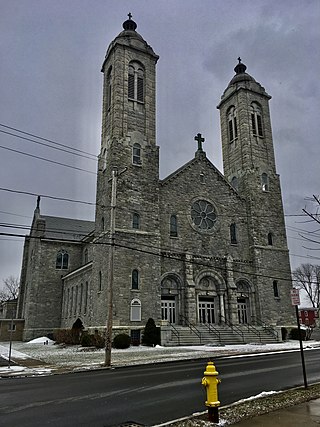
East Syracuse is an incorporated village and a suburb of the City of Syracuse in eastern Onondaga County, New York, United States. As of the 2020 census, the population was 3,078. It is located immediately east of Syracuse, in the town of DeWitt.

Lyncourt is a hamlet in Onondaga County, New York, United States. The population was 4,250 at the 2010 census.

Solvay is a village located in the town of Geddes, Onondaga County, New York, United States, and a suburb of the city of Syracuse. As of the 2020 census, the population was 6,645. The village is named after the Solvay brothers, Belgian inventors of the chemical process employed by the Solvay Process Company, formerly the major industry of the village.

Tipperary Hill, sometimes known as Tipp Hill, is a district in the city of Syracuse, New York. It is largely settled by immigrants from Ireland, especially from County Tipperary. It makes up half of Syracuse's Far Westside neighborhood.

Parish is a village located in the town of Parish, in Oswego County, New York, United States. This village is part of the Syracuse metropolitan area. Its population was 447 as of the census of 2020.
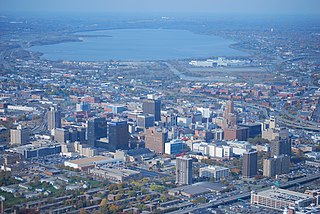
Downtown Syracuse is the economic center of Syracuse, New York, and Central New York, employing over 30,000 people, and housing over 4,300.

The Diocese of Syracuse is a Latin Church ecclesiastical territory, or diocese, of the Catholic Church in Upstate New York in the United States. Its episcopal see is located in Syracuse. It is a suffragan diocese in the ecclesiastical province of the metropolitan Archdiocese of New York.

Skunk City is a Syracuse, New York neighborhood that for a number of years has been known by this name, and before 1886 was a rural part of the Town of Geddes. The area was first inhabited by Irish immigrants but later grew to include a veriety of ethnic communities. The neighborhood boundaries are Geddes St. on the east, Grand Ave. and Burnet Park on the north, and West Onondaga St. on the south. Harbor Brook Retention area is to the west. The root of neighborhood's name is not explicitly stated. While some attribute it to the unusually high number of skunks that roam the area at night, others cite the smell given off by the local creek.
The Northside is a neighborhood in the city of Syracuse, New York (USA) consisting of a residential area bordered by commercial corridors. As defined by Syracuse's "Tomorrow's Neighborhoods Today" planning system, the Northside is a large section of the city of Syracuse, covering almost four square miles. There are 16 census tracts, within which are 36 census blockgroups. Thus, there are many sub-regions that have developed with their own unique identities, such as the Near Northeast neighborhood, the Little Italy District and the Hawley-Green Historic District.

The Toyota Coliseum, formerly the State Fair Coliseum, is an indoor arena in Geddes, New York. It hosted the Syracuse Nationals from 1946 to 1951 as well as the Syracuse Stars of the American Hockey League. It also served as a temporary home to the Syracuse Orange men's basketball team following the burning of their on-campus gymnasium, Archbold Gymnasium, in 1947 until the opening of the Onondaga County War Memorial in 1951. The arena held 7,500 people and was built in 1927. It is owned by the State of New York under the Great New York State Fair. After undergoing renovations, the seating capacity was reduced to 3,600 and is now primarily used for horse shows. Much of the previous infrastructure, including the scoreboard and announcers booth, are still in place.

Syracuse New Times was a weekly alternative newspaper published in Syracuse, New York, by William Brod and distributed throughout the Central New York region. It was owned by All Times Publishing LLC. The publication was released every Wednesday, printing 36,000 copies and distributed to approximately 1150 locations in Central New York. After an unsuccessful trial as a paid subscription-based paper, the New Times published its final issue on 26 June 2019.

WSYR-FM is a commercial radio station licensed to Solvay, New York, and serving the Syracuse metropolitan area and Central New York. Owned and operated by iHeartMedia, it broadcasts a talk radio format, simulcast with WSYR 570 AM since January 2011. The studios and offices are on Plum Street in Syracuse.
Pioneer Homes, in Syracuse, New York, was one of the earliest government public housing projects in the United States. Pioneer Homes was completed in 1941 and remains fully occupied even as another nearby public housing project was demolished.
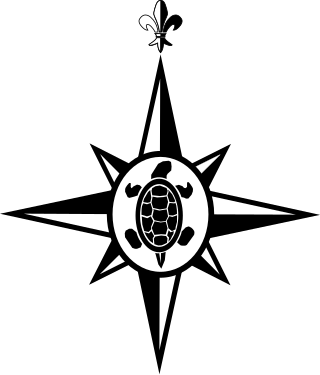
Sainte Marie among the Iroquois was a 17th-century French Jesuit mission located in the middle of the Onondaga nation of the Iroquois. It was located on Onondaga Lake near modern-day Syracuse, New York. The original mission, led by Jesuit priest Simon Le Moyne, was in use only from 1656 to 1658.
The Zen Center of Syracuse, temple name Hoen-ji, is a Rinzai Zen Buddhist practice center in Syracuse, New York, one of the oldest continuously running Zen centers in the United States. Founded in 1972, the center is currently led by Shinge Roko Sherry Chayat Roshi. Originally at 111 Concord Place, the meditation hall is now located in the former carriage house at 266 West Seneca Turnpike and offers Zen practice for laypeople. Several clergy and practitioners live in a house next door and in the Joshua Forman house, where programs are also conducted. The Zen Center of Syracuse began as a group of graduate students from Syracuse University, with Chayat eventually becoming the center's leader. In addition to Zen practice, the center also provides some instruction in Tibetan Buddhism. According to The Encyclopedia of Women and Religion in North America, "The Syracuse Zen Center also leads meditation at Syracuse University, Syracuse area schools, recovery and justice system institutions, hospitals and corporations." The center also won two awards for their restoration of The Forman House from the Preservation Association of Central New York. This house was instrumental during the War of 1812 and the American Civil War, for it was a bandage assembly area for wounded troops.

St George Hanover Square was a civil parish in the metropolitan area of Westminster, Middlesex, later Greater London, England. The creation of the parish accompanied the building of the Church of St George's, Hanover Square, constructed by the Commission for Building Fifty New Churches to meet the demands of the growing population. The parish was formed in 1724 from part of the ancient parish of St Martin in the Fields in the Liberty of Westminster and county of Middlesex. It included some of the most fashionable areas of the West End, including Belgravia and Mayfair. Civil parish administration, known as a select vestry, was dominated by members of the British nobility until the parish adopted the Vestries Act 1831. The vestry was reformed again in 1855 by the Metropolis Management Act. In 1889 the parish became part of the County of London and the vestry was abolished in 1900, replaced by Westminster City Council. The parish continued to have nominal existence until 1922. As created, it was a parish for both church and civil purposes, but the boundaries of the ecclesiastical parish were adjusted in 1830, 1835 and 1865.

The Church of the Saviour (Syracuse) is a chapel in the Episcopal Diocese of Central New York. It is an Anglo-Catholic Episcopal parish noteworthy for its historically significant architecture and decor, which took shape in the late nineteenth and early twentieth centuries.
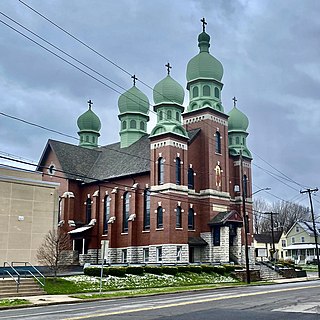
St. John the Baptist Ukrainian Catholic Church is a parish of the Ukrainian Greek Catholic Church located in Syracuse, New York, at the corner of Tompkins Street and Wilbur Avenue. Constructed in 1913, it was the first Eastern Catholic church in the city.
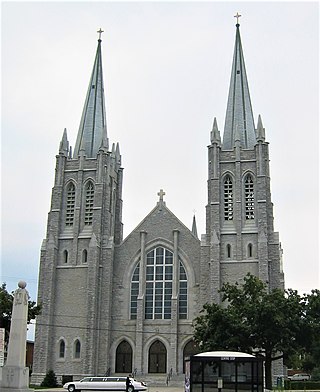
The Basilica of the Sacred Heart of Jesus is a Catholic parish church and minor basilica in Syracuse, New York. It is located at 927 Park Avenue in the Westside neighborhood. The building was designated a minor basilica by Pope John Paul II on August 27, 1998, and dedicated on October 3, 1999.